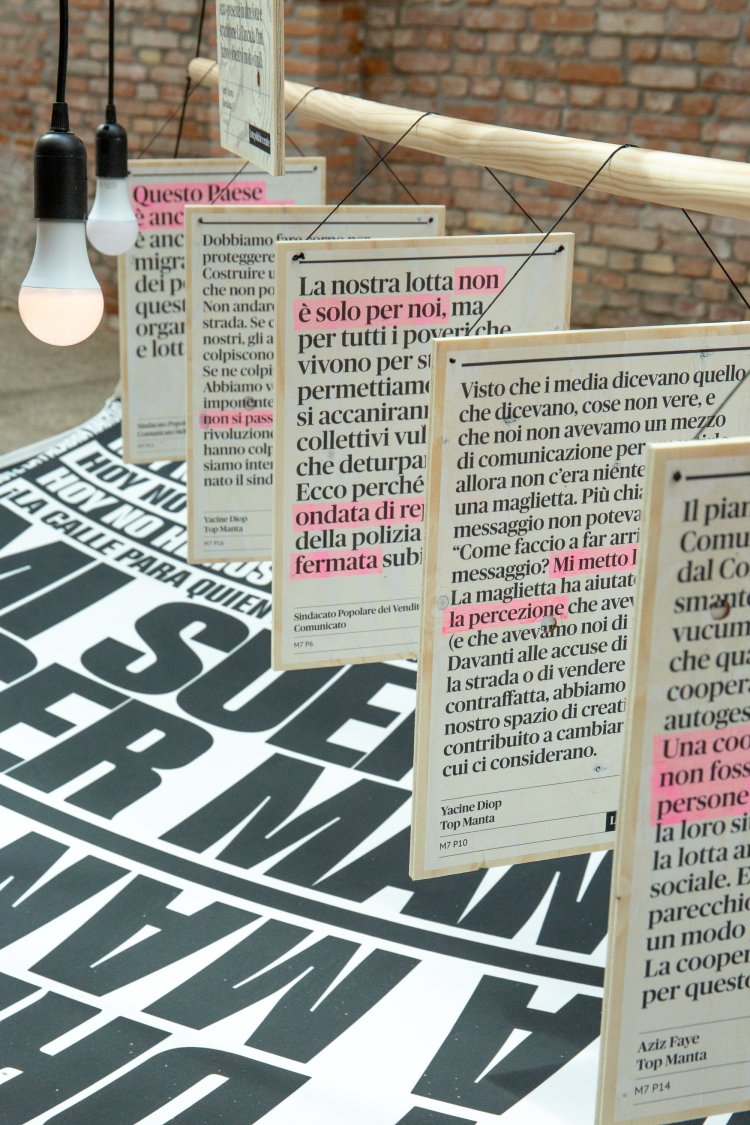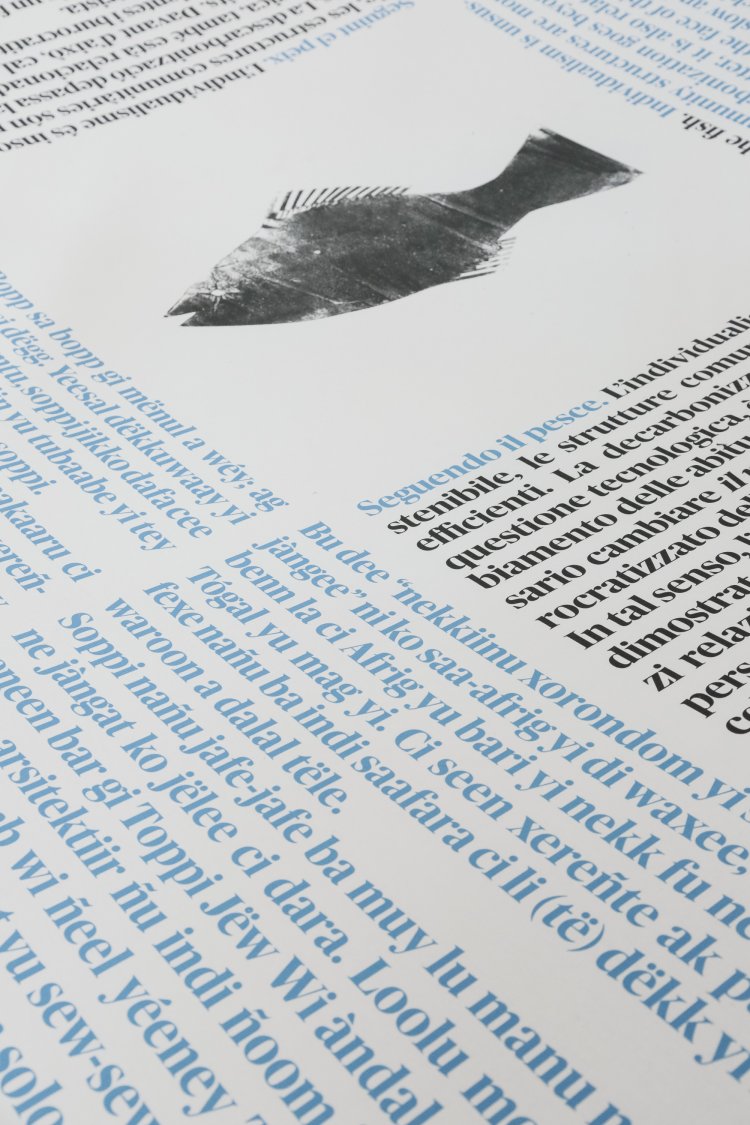“Catalonia in Venice_ Following the Fish” at the Venice Biennale appeals to decolonize and decarbonize architecture from a migrant perspective
The Institute Ramon Llull has presented the Collateral Event Catalonia in Venice_ Following the Fish at the 18th International Architecture Exhibition - Venice Biennale, which will be on display at the Docks Cantieri Cucchini in San Pietro di Castello until November 26. Curated by Leve members Daniel Cid, Eva Serrats and Francesc Pla, in collaboration with Top Manta, aims to encourage the dialogue between architecture and African migration, rethinking urban space and fighting for egalitarian urbanism. The project is divided into two parts: Street Market, the exhibition that showcases the narrative of the African diaspora in Venice, and the results of the laboratory The Reparation Atelier.
“Catalonia in Venice_ Following the Fish” at the Venice Biennale appeals to decolonize and decarbonize architecture from a migrant perspective
The Collaterale Event is organized by the Institut Ramon Llull and curated by Leve in collaboration with Top Manta.
The Institute Ramon Llull has presented the Evento Collaterale Catalonia in Venice_ Following the Fish at the 18th International Architecture Exhibition - Venice Biennale, which will be on display at the Docks Cantieri Cucchini in San Pietro di Castello until November 26. The project, curated by Leve members Daniel Cid, Eva Serrats and Francesc Pla, in collaboration with Top Manta, aims to encourage the dialogue between architecture and African migration, rethinking urban space and fighting for an egalitarian urbanism.
The curator Daniel Cid has highlighted that "this is an essay on how to change the conditions of architecture from an African perspective to create welcoming and relational spaces, which foster the art of connections between individuals and communities".
Catalonia in Venice_ Following the Fish, which revolves around the architectural axes of work, housing and community spaces from the perspective of the African diaspora in Catalonia, is divided into two parts: Street Market, the exhibition that showcases the narrative of the African diaspora in Venice, and the results of the laboratory The Reparation Atelier. The installation that takes place/shape in Venice with an image genuinely mantera, simple, low-cost and easy to assemble, transforms the warehouse of the former Cantieri Cucchini into a Street Market in constant transformation. Nine blankets, support, and image of the exhibition, are arranged floating on the floor showing the contents of the journey made by the migrants.
Following the Fish shows an extremely realistic and critical narrative embodied in the blankets that show the condemnation and refuge of migrants when they arrive in Europe. The narrative is complemented by panels that expand its content, including new contributions, references and comments through drawings, writings and images that encourage the visitor to generate an exchange of ideas and debates. With The Reparation Atelier, the project becomes a laboratory for the future.
Through the conversations held by members of the Top Manta collective with more than a hundred students of twenty-six nationalities and six European universities -Escola Tècnica Superior d'Arquitectura del Vallès (ETSAVUPC), Barcelona (ETSAB-UPC) and Reus (ETSA-URV), Winchester School of Art, University of Southampton, Lund University and the Politecnico di Milano-, the aim is to give shape to the resulting ideas to solve different problematics: Ceebu Jeen (traditional Senegalese stew) proposes collective kitchens as an alternative in the current soup kitchens, which guarantee an open access to everyone where to enjoy gastronomy and with proximity products. Teranga (a concept that represents the hospitality and generosity of the country) presents housing solutions in open spaces, to rethink the types of cohousing, and in Sutura (a traditional Senegalese sewing technique characterized by its high craft quality), the students propose the conversion of empty locals on the ground floors of buildings as catalysts for transformative social uses for rest, storage, as a meeting point or prayer). The Reparation Atelier aims to imagine, visualize and claim shared futures based on different ways of negotiating and resolving conflicts. It seeks new ways of looking at and integrating proposals that challenge the migrant community, the architectural community, and the public administration. It is an experiment at the service of the city and local institutions.
The director of the Institute Ramon Llull, Pere Almeda, explained that "Catalan culture is presented at the Venice Architecture Biennale with a transformation project made from many layers and contents, which represents the reverse to the xenophobic discourse of the extreme right present in many countries, such as Italy. The project curated by Leve and from the perspective of Top Manta challenges us and questions the dominant paradigms, highlighting the valuable knowledge of their experience as a migrant collective and raising new questions about architecture and urban space". Through the critical and propositive vision of the migrant communities on the European territories of arrival, Following the Fish seeks to resituate/redefine the places from where architecture is practiced and the role of architects. For his part, the Minister of Culture of the Catalan Government, Natàlia Garriga, has stated that "in these moments when we are questioning issues such as sustainability, the climate or other ways of living, it is very interesting to look again towards Africa, listen and above all learn from communities that are from home This proposal challenges you, provokes you and makes you think".
For further information:
Labóh | Miriam Giordano – Gemma Pascual +34 606 602 230 | +34 636 663 097 press@laboh.net







